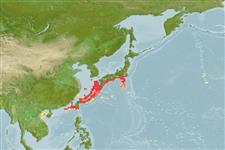Common names from other countries
分类 / Names
俗名 | 同种异名 | Catalog of Fishes(属, 种) | ITIS | CoL | WoRMS | Cloffa
Myxini
盲鳗纲 (丑鱼) (hagfishes) >
Myxiniformes (Hagfishes) >
Myxinidae (Hagfishes) > Eptatretinae
Etymology: Eptatretus: hepta (Gr.), seven; tretos (Gr.), perforated (i.e., with holes), referring to seven gill apertures on what would later be described as Homea banksii (=E. cirrhatus) [range within genus is 6-14 pairs of gill apertures]. (See ETYFish); sheni: In honor of Shih (or Shieh)- Chieh Shen, National Taiwan University, for his contributions to the knowledge of Taiwanese fishes. (See ETYFish).
Environment: milieu / climate zone / depth range / distribution range
生态学
海洋 深海底的; 非迁移的; 深度上下限 200 - 800 m (Ref. 31276). 深水域
Northwest Pacific: Taiwan.
西北太平洋: 外海的台灣西南方。
大小 / 重量 / 年龄
Maturity: Lm ? range ? - ? cm
Max length : 43.0 cm TL 雄鱼/尚未辨别雌雄; (Ref. 31276)
简单描述
检索表 | 型态特徵 | 形态测量图
6 pairs gill pouches and gill apertures; gill apertures usually closely spaced in a straight line, but never crowded together; fused unicuspid teeth 3/3; dental formula: 11 + 3/3 + 10; no whitish mid-dorsal stripe; eye spots prominent.
6 对鳃囊与鳃孔; 鳃孔通常间隔很密的成一直线, 但是从不挤在一起; 融合的单犬齿 3/3; 齿式: 11+3/3+10; 没有微白色的背部中央斑纹; 眼斑突出的。
Life cycle and mating behavior
Maturities | 繁殖 | Spawnings | Egg(s) | Fecundities | 仔鱼
Copulatory organ absent. The gonads of hagfishes are situated in the peritoneal cavity. The ovary is found in the anterior portion of the gonad, and the testis is found in the posterior part. The animal becomes female if the cranial part of the gonad develops or male if the caudal part undergoes differentiation. If none develops, then the animal becomes sterile. If both anterior and posterior parts develop, then the animal becomes a functional hermaphrodite. However, hermaphroditism being characterised as functional needs to be validated by more reproduction studies (Ref. 51361 ).西北太平洋: 外海的台灣西南方。
Fernholm, B., 1998. Hagfish systematics. p. 33-44. In J.M. Jørgensen, J.P. Lomholt, R.E. Weber and H. Malte (eds.) The biology of hagfishes. Chapman & Hall, London. 578 p. (Ref. 31276)
CITES (Ref. 128078)
Not Evaluated
人类利用
工具
特别资料
下载 XML
网络资源
Estimates based on models
Preferred temperature (Ref.
115969): 9.3 - 16, mean 11.8 (based on 34 cells).
Phylogenetic diversity index (Ref.
82804): PD
50 = 0.5000 [Uniqueness, from 0.5 = low to 2.0 = high].
Bayesian length-weight: a=0.00204 (0.00092 - 0.00452), b=2.93 (2.73 - 3.13), in cm Total Length, based on LWR estimates for this (Sub)family-body shape (Ref.
93245).
营养阶层 (Ref.
69278): 4.1 ±0.7 se; based on size and trophs of closest relatives
回复力 (Ref.
120179): 低的, 最小族群倍增时间4.5 - 14 年 (Fec assumed to be <100).
Fishing Vulnerability (Ref.
59153): Low to moderate vulnerability (33 of 100).
